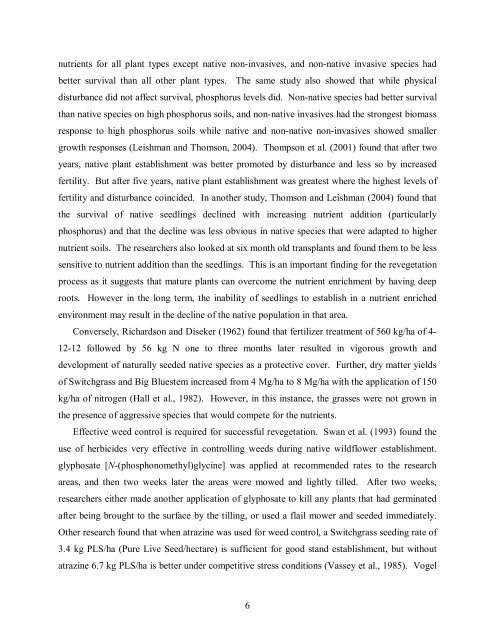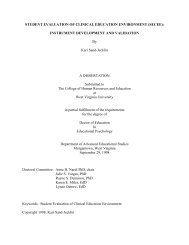The Use of Native Plants for Revegetation along West Virginia ...
The Use of Native Plants for Revegetation along West Virginia ...
The Use of Native Plants for Revegetation along West Virginia ...
Create successful ePaper yourself
Turn your PDF publications into a flip-book with our unique Google optimized e-Paper software.
nutrients <strong>for</strong> all plant types except native non-invasives, and non-native invasive species had<br />
better survival than all other plant types. <strong>The</strong> same study also showed that while physical<br />
disturbance did not affect survival, phosphorus levels did. Non-native species had better survival<br />
than native species on high phosphorus soils, and non-native invasives had the strongest biomass<br />
response to high phosphorus soils while native and non-native non-invasives showed smaller<br />
growth responses (Leishman and Thomson, 2004). Thompson et al. (2001) found that after two<br />
years, native plant establishment was better promoted by disturbance and less so by increased<br />
fertility. But after five years, native plant establishment was greatest where the highest levels <strong>of</strong><br />
fertility and disturbance coincided. In another study, Thomson and Leishman (2004) found that<br />
the survival <strong>of</strong> native seedlings declined with increasing nutrient addition (particularly<br />
phosphorus) and that the decline was less obvious in native species that were adapted to higher<br />
nutrient soils. <strong>The</strong> researchers also looked at six month old transplants and found them to be less<br />
sensitive to nutrient addition than the seedlings. This is an important finding <strong>for</strong> the revegetation<br />
process as it suggests that mature plants can overcome the nutrient enrichment by having deep<br />
roots. However in the long term, the inability <strong>of</strong> seedlings to establish in a nutrient enriched<br />
environment may result in the decline <strong>of</strong> the native population in that area.<br />
Conversely, Richardson and Diseker (1962) found that fertilizer treatment <strong>of</strong> 560 kg/ha <strong>of</strong> 4-<br />
12-12 followed by 56 kg N one to three months later resulted in vigorous growth and<br />
development <strong>of</strong> naturally seeded native species as a protective cover. Further, dry matter yields<br />
<strong>of</strong> Switchgrass and Big Bluestem increased from 4 Mg/ha to 8 Mg/ha with the application <strong>of</strong> 150<br />
kg/ha <strong>of</strong> nitrogen (Hall et al., 1982). However, in this instance, the grasses were not grown in<br />
the presence <strong>of</strong> aggressive species that would compete <strong>for</strong> the nutrients.<br />
Effective weed control is required <strong>for</strong> successful revegetation. Swan et al. (1993) found the<br />
use <strong>of</strong> herbicides very effective in controlling weeds during native wildflower establishment.<br />
glyphosate [N-(phosphonomethyl)glycine] was applied at recommended rates to the research<br />
areas, and then two weeks later the areas were mowed and lightly tilled. After two weeks,<br />
researchers either made another application <strong>of</strong> glyphosate to kill any plants that had germinated<br />
after being brought to the surface by the tilling, or used a flail mower and seeded immediately.<br />
Other research found that when atrazine was used <strong>for</strong> weed control, a Switchgrass seeding rate <strong>of</strong><br />
3.4 kg PLS/ha (Pure Live Seed/hectare) is sufficient <strong>for</strong> good stand establishment, but without<br />
atrazine 6.7 kg PLS/ha is better under competitive stress conditions (Vassey et al., 1985). Vogel<br />
6












